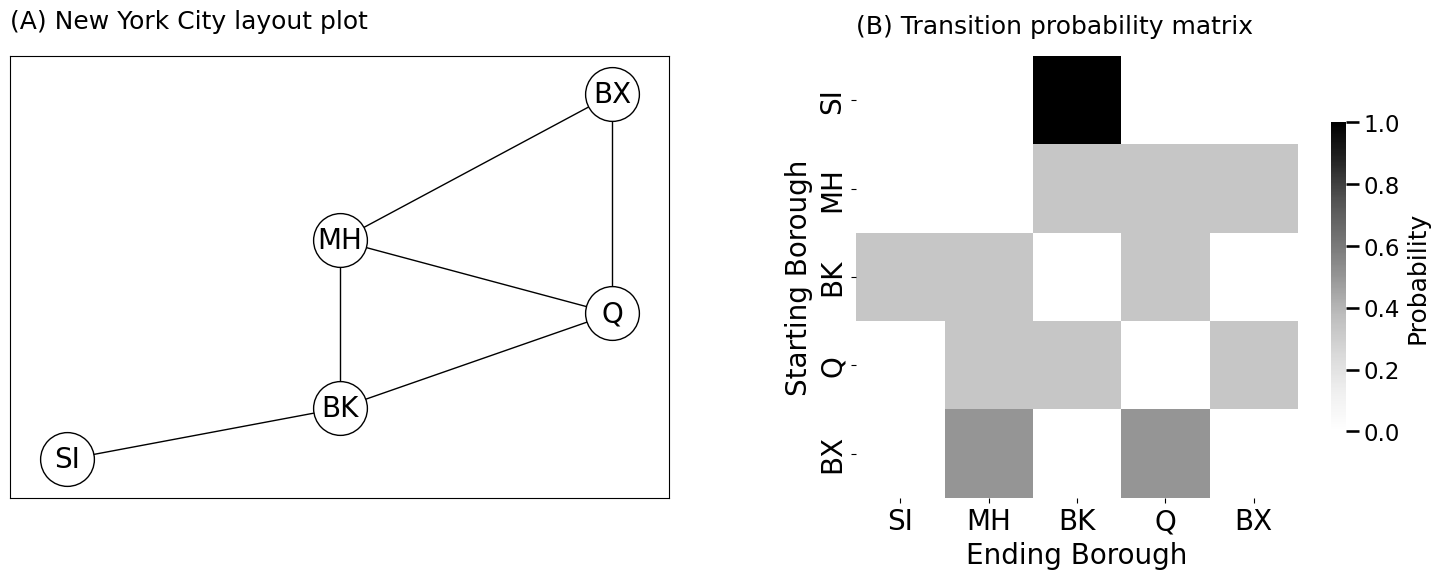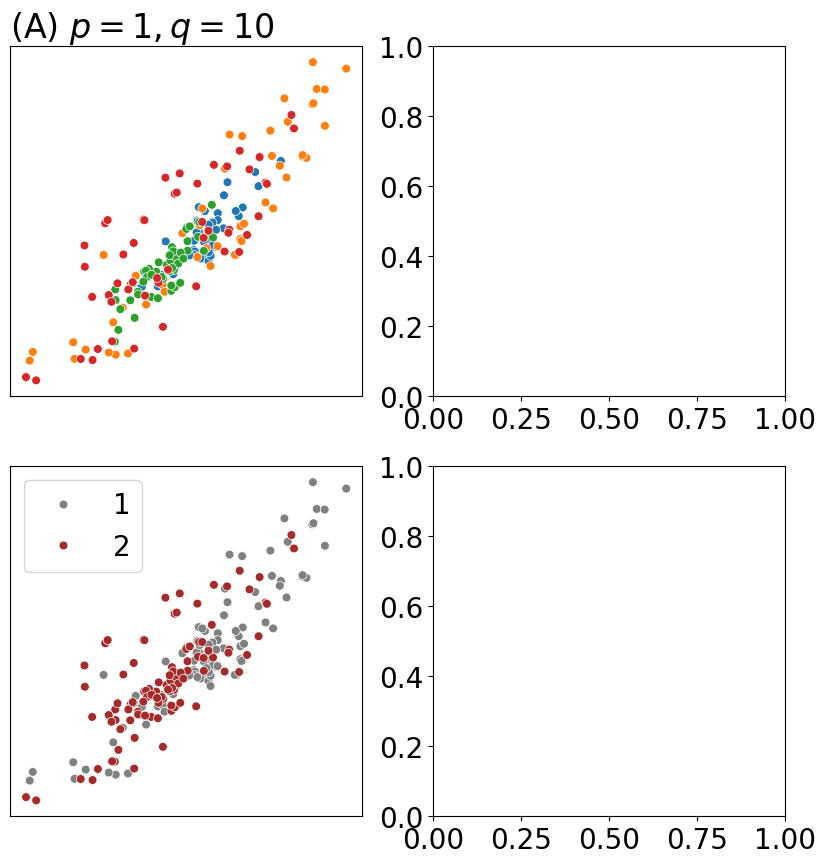9.2 Random walks and diffusion-based methods#
mode = "svg"
import matplotlib
font = {'family' : 'Dejavu Sans',
'weight' : 'normal',
'size' : 20}
matplotlib.rc('font', **font)
import matplotlib
from matplotlib import pyplot as plt
import numpy as np
# define the node names
node_names = np.array(["SI", "MH", "BK", "Q", "BX"])
# define the adjacency matrix
A = np.array([[0,0,1,0,0], # Staten Island neighbors Brooklyn
[0,0,1,1,1], # Manhattan Neighbors all but Staten Island
[1,1,0,1,0], # Brooklyn neighbors all but Bronx
[0,1,1,0,1], # Queens neighbors all but Staten Island
[0,1,0,1,0]]) # Bronx neighbors Manhattan and Queens
# compute the degree of each node
di = A.sum(axis=0)
# the probability matrix is the adjacency divided by
# degree of the starting node
P = (A / di).T
import networkx as nx
from graphbook_code import heatmap
import os
fig, axs = plt.subplots(1, 2, figsize=(15, 6))
# create an undirected network G
G = nx.Graph()
# add the nodes like before
G.add_node("SI", pos=(2,1))
G.add_node("MH", pos=(4,4))
G.add_node("BK", pos=(4,1.7))
G.add_node("Q", pos=(6,3))
G.add_node("BX", pos=(6,6))
# specify boroughs that are connected to one another
pos = nx.get_node_attributes(G, 'pos')
G.add_edge("SI", "BK")
G.add_edge("MH", "BK")
G.add_edge("BK", "Q")
G.add_edge("MH", "Q")
G.add_edge("MH", "BX")
G.add_edge("Q", "BX")
# plotting
nx.draw_networkx(G, with_labels=True, node_color="white", pos=pos,
font_size=20, node_size=1500, font_color="black", arrows=False,
width=1, edgecolors="#000000", ax=axs[0])
axs[0].set_title("(A) New York City layout plot", pad=20, loc="left", fontsize=18)
heatmap(P, title="(B) Transition probability matrix", xtitle="Ending Borough", ytitle="Starting Borough",
xticklabels=list(node_names), yticklabels=list(node_names), ax=axs[1], legend_title="Probability")
fig.tight_layout()
fname = "first_ord"
os.makedirs("Figures", exist_ok=True)
if mode != "png":
os.makedirs(f"Figures/{mode:s}", exist_ok=True)
fig.savefig(f"Figures/{mode:s}/{fname:s}.{mode:s}")
os.makedirs("Figures/png", exist_ok=True)
fig.savefig(f"Figures/png/{fname:s}.png")

fig, axs = plt.subplots(1, 3, figsize=(18, 5), gridspec_kw={"width_ratios": [1, 1, 1]})
G2 = nx.Graph()
G2.add_node("MH", pos=(4,4))
G3 = nx.Graph()
G3.add_node("BK", pos=(4,1.7))
G3.add_node("Q", pos=(6,3))
G3.add_node("BX", pos=(6,6))
G3.add_edge("MH", "BK")
G3.add_edge("MH", "Q")
G3.add_edge("MH", "BX")
# plotting
nx.draw_networkx(G, with_labels=True, node_color="white", pos=pos,
font_size=20, node_size=1500, font_color="black", arrows=False,
width=1, edgecolors="#000000", ax=axs[0])
nx.draw_networkx(G3, with_labels=True, node_color="gray", pos=pos,
font_size=20, node_size=1500, font_color="white", arrows=False,
width=6, edgecolors="#000000", ax=axs[0])
nx.draw_networkx(G2, with_labels=True, node_color="black", pos=pos,
font_size=20, node_size=1500, font_color="white", arrows=False,
width=1, edgecolors="#000000", ax=axs[0])
axs[0].set_title("(A) First-order random walk", pad=20, loc="left", fontsize=18)
heatmap(P, title="(B) Transition probability matrix", xtitle="Ending Borough", ytitle="Starting Borough",
xticklabels=list(node_names), yticklabels=list(node_names), ax=axs[1], legend_title="Probability")
axs[1].set_title("(B) Transition probability matrix", pad=15, fontsize=18, loc="left")
axs[1].add_patch(plt.Rectangle((0, 1), 5, 1, linewidth=4, edgecolor="black", facecolor="none"))
nx.draw_networkx(G, with_labels=True, node_color="white", pos=pos,
font_size=20, node_size=1500, font_color="black", arrows=False,
width=1, edgecolors="#000000", ax=axs[2])
nx.draw_networkx(G3, with_labels=True, node_color="gray", pos=pos,
font_size=20, node_size=1500, font_color="white", arrows=False,
width=6, edgecolors="#000000", ax=axs[2])
nx.draw_networkx(G2, with_labels=True, node_color="black", pos=pos,
font_size=20, node_size=1500, font_color="white", arrows=False,
width=1, edgecolors="#000000", ax=axs[2])
axs[2].set_title("(C) Biased second-order random walk", pad=20, loc="left", fontsize=18)
axs[2].annotate("1/p", xy=(3.3, 2.8), fontsize=25, color="black")
axs[2].annotate("1/q", xy=(4.45, 5.25), fontsize=25, color="black")
axs[2].annotate("1", xy=(5, 3.7), fontsize=25, color="black")
fig.tight_layout()
fname = "one_step"
if mode != "png":
fig.savefig(f"Figures/{mode:s}/{fname:s}.{mode:s}")
fig.savefig(f"Figures/png/{fname:s}.png")

x0 = np.array([0,1,0,0,0]) # x vector indicating we start at MH
ps0 = P.T @ x0 # p vector for timestep 1 starting at node MH at time 0
# choose the next node using the probability vector we calculated
next_node = np.random.choice(range(0, len(node_names)), p=ps0)
print(f"Next node: {node_names[next_node]:s}")
Next node: BK
p = 5 # return parameter
q = 1/2 # in-out parameter
bias_vector = np.ones(len(node_names))
bias_vector[node_names == "BX"] = 1/q
bias_vector[node_names == "BK"] = 1/p
xt = np.array([0,1,0,0,0]) # x vector indicating we start at MH
pst = P.T @ xt # probability vector is Pt*xt
bias_factors = pst*bias_vector
biased_pst = bias_factors/bias_factors.sum()
# choose the next node using the second-order biased transition probability
next_node = np.random.choice(range(0, len(node_names)), p=biased_pst)
print(f"Next node: {node_names[next_node]:s}")
Next node: BX
from graphbook_code import lpm_heatmap
fig, axs = plt.subplots(2, 2, figsize=(15, 5))
lpm_heatmap(bias_vector.reshape(1, -1), title="(A) Bias vector $\\vec{\\alpha}_{MH}(5, \\frac{1}{2}, Q)$",
ax=axs[0][0], legend_title="Bias", vmin=0, vmax=2,
xticks=[0.5, 1.5, 2.5, 3.5, 4.5], xticklabels=["SI", "MH", "BK", "Q", "BX"], shrink=1,
annot=True, linewidths=0.05, linecolor="black", clip_on=False)
lpm_heatmap(bias_factors.reshape(1, -1), title="(B) Biased transition factors $\\vec{\\beta}_{MH}(5, \\frac{1}{2}, Q)$",
ax=axs[0][1], legend_title="Bias factor", vmin=0, vmax=1,
xticks=[0.5, 1.5, 2.5, 3.5, 4.5], xticklabels=["SI", "MH", "BK", "Q", "BX"], shrink=1,
annot=True, linewidths=0.05, linecolor="black", clip_on=False)
lpm_heatmap(pst.reshape(1, -1), title="(C) First-order transition probability $\\vec{p}_{MH}$",
ax=axs[1][0], legend_title="Probability", vmin=0, vmax=1,
xticks=[0.5, 1.5, 2.5, 3.5, 4.5], xticklabels=["SI", "MH", "BK", "Q", "BX"], shrink=1,
annot=True, linewidths=0.05, linecolor="black", clip_on=False)
lpm_heatmap(biased_pst.reshape(1, -1), title="(C) Second-order transition probability $\\vec{p}_{MH}(5, \\frac{1}{2}, Q)$",
ax=axs[1][1], legend_title="Probability", vmin=0, vmax=1,
xticks=[0.5, 1.5, 2.5, 3.5, 4.5], xticklabels=["SI", "MH", "BK", "Q", "BX"], shrink=1,
annot=True, linewidths=0.05, linecolor="black", clip_on=False)
fig.tight_layout()
fname = "trans_vecs"
if mode != "png":
fig.savefig(f"Figures/{mode:s}/{fname:s}.{mode:s}")
fig.savefig(f"Figures/png/{fname:s}.png")

from graphbook_code import dcsbm
nk = 100 # 100 nodes per community
zs = np.repeat([1, 2], nk)
B = np.array([[0.6, 0.3], [0.3, 0.6]])
theta = b = np.repeat([1, .2, 1, .2], nk // 2)
deg_map = {1: "Core", 0.2: "Per."}
zs_deg = [f"{deg_map[theta[i]]:s}" for i in range(len(theta))]
zs_aug = [f"{z:d}, {deg:s}" for z, deg in zip(zs, zs_deg)]
A, P = dcsbm(zs, theta, B, return_prob=True)
fig, axs = plt.subplots(1, 2, figsize=(12, 6))
heatmap(P, vmin=0, vmax=0.6, title="(A) Probability matrix", inner_hier_labels=zs, legend_title="Probability", ax=axs[0])
heatmap(A.astype(int), title="(B) Adjacency matrix", inner_hier_labels=zs, ax=axs[1])
fig.tight_layout()
fname = "diff_ex"
if mode != "png":
fig.savefig(f"Figures/{mode:s}/{fname:s}.{mode:s}")
fig.savefig(f"Figures/png/{fname:s}.png")

from graspologic.embed import node2vec_embed
import networkx as nx
p=1; q=10; T=200; r=500
d = 4
np.random.seed(0)
Xhat1, _ = node2vec_embed(nx.from_numpy_array(A),
return_hyperparameter=float(p), inout_hyperparameter=float(q),
dimensions=d, num_walks=r, walk_length=T)
from graphbook_code import plot_latents
fig, axs = plt.subplots(2, 2, figsize=(10, 10))
plot_latents(Xhat1, ax=axs[0][0], s=40, labels=zs_aug, title="(A) $p = 1, q = 10$")
axs[0][0].get_legend().remove()
# Remove x and y ticks
axs[0][0].set_xticks([])
axs[0][0].set_yticks([])
# Remove axis numbers
axs[0][0].set_xticklabels([])
axs[0][0].set_yticklabels([])
plot_latents(Xhat1, ax=axs[1][0], s=40, labels=zs, title="", palette={1: "gray", 2: "brown"})
axs[1][0].set_xticks([])
axs[1][0].set_yticks([])
# Remove axis numbers
axs[1][0].set_xticklabels([])
axs[1][0].set_yticklabels([])
[]

p=1; q=1/10; T=200; r=500
d = 4
np.random.seed(0)
Xhat2, _ = node2vec_embed(nx.from_numpy_array(A), return_hyperparameter=float(p), inout_hyperparameter=float(q),
dimensions=d, num_walks=r, walk_length=T)
plot_latents(Xhat2, ax=axs[0][1], s=40, labels=zs_aug, title="(B) $p = 1, q = \\frac{1}{10}$")
# Remove x and y ticks
axs[0][1].set_xticks([])
axs[0][1].set_yticks([])
# Remove axis numbers
axs[0][1].set_xticklabels([])
axs[0][1].set_yticklabels([])
plot_latents(Xhat2, ax=axs[1][1], s=40, labels=zs_deg, title="", palette={"Core": "black", "Per.": "#BB00BB"})
axs[1][1].set_xticks([])
axs[1][1].set_yticks([])
# Remove axis numbers
axs[1][1].set_xticklabels([])
axs[1][1].set_yticklabels([])
fig.tight_layout()
fname = "diff_pairplot"
if mode != "png":
fig.savefig(f"Figures/{mode:s}/{fname:s}.{mode:s}")
fig.savefig(f"Figures/png/{fname:s}.png")
fig

